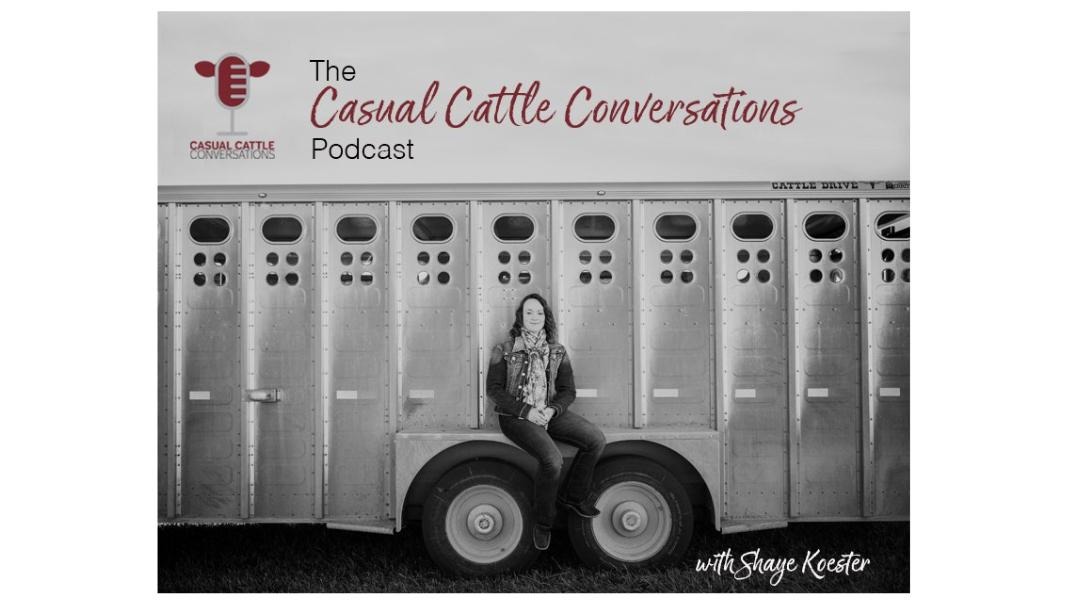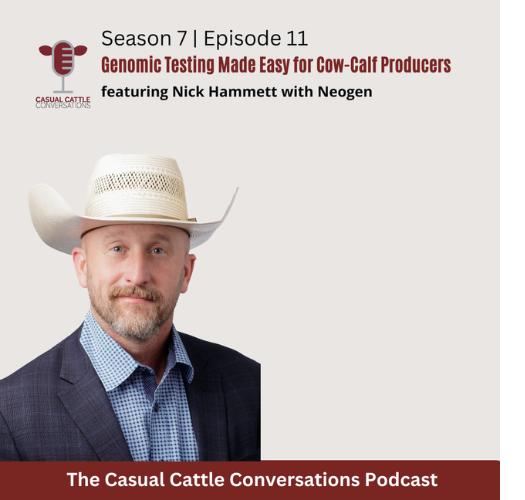The Casual Cattle Conversations Podcast: Genomic Testing Made Easy for Cow-Calf Producers
Thursday, March 14, 2024
Reference: Podcast Corner

Genomic Testing Made Easy for Cow-Calf Producers
March 11, 2024 | Written By Shaye Koester
At first, the words genomic testing might immediately make you think about seedstock operations. However, their application on commercial cow-calf operations has proven to be beneficial for operations of all sizes. “I think that's maybe one of the biggest values of genomics is that you don't have to be a seedstock operator. You can get about 80% of the value of a genomically enhanced EPD with just genomic testing. So, you're not doing all the work and labor associated with what a seedstock operator might be doing to collect phenotypic data.” said Hammett. It’s as simple as taking one small tissue sample from the ear of the animal and sending it into the lab. But, how can one small sample provide so much information? Hammet said, “We’re looking at your animal's genome. And we're saying we know these are the genes that animal has. And this is the production characteristics related to the genetic profile of that animal. We do that at both the seedstock and the commercial level.” Essentially, years of data collection on a multitude of traits followed by research is paying off for cattle producers.

Click Here to listen to Shaye's Podcast
After the lab is done analyzing the tissue samples, you’ll get a report back with 17 different traits and 3 indexes. Each animal receives a score that ranges from 1 to 10 for each trait and index. These scores are not true EPDs but can be used to select replacement heifers, make sounder purchasing decisions for bulls, and open up marketing opportunities. “The best starting point with the greatest return on investment is testing your potential replacement females to make more accurate decisions on which ones will stay in the herd longer. But you can also use either that data or run the Feeder Test to qualify and characterize the steers you'll be marketing as well. This information helps create trust and transparency with potential buyers who will more than likely pay you more money because they know more about the genomics that they're actually buying and have a more accurate sense of how the steers will perform in the feedlot,” said Hammett.
Outside of building relationships with cattle buyers and selecting replacement heifers, genomic testing also provides commercial cattlemen with more direction when purchasing bulls. Hammett said, “We have a number of seedstock operators who encourage this type of testing for their commercial customers, so that they can help their commercial customers make better purchasing decisions after sales. I think a lot of commercial operators fall into a rut of buying the same types of bulls each year whether that bull is strong in calving ease, high growth, high marbling, etc. Over time your herd develops certain strengths and weaknesses that we aren’t aware of just by looking at them. What this test allows us to do is objectively measure those strengths and weaknesses and determine what areas you need to focus on improving when you are buying bulls.” Seedstock producers can provide sounder advice and commercial producers can buy bulls with confidence.
Genomic testing isn’t an input cost that is frequently accounted for in budgets like feed, fuel, vaccines, and other necessities of operating a ranch. However, it is a tool that allows you to cut back on other inputs because you can select for heifers that have your ideal combination of maternal traits, performance, and feed efficiency. “Right now, input costs are extremely high in every facet. It costs a lot to maintain a cow. So genomic expense appears to be another additional cost that we're adding on to that. But with those high input cost, we must figure out how to be as efficient as possible. So how do we select the right females? How do we make the right mating decisions so that we can drive down those feed costs and those input costs and I think genomics are a key to doing that. If you look at variable rate application in farming today, many large farmers don't farm without it, they understand that it makes sense to only put input into places where you can get output and we're just bringing that same type of concept and technology to the beef industry,” said Hammett.
As the spring calf crop hits the ground and you catch yourself dreaming of how they will perform in your herd someday. Consider how you can invest in improving your bottom line and the performance of your cows with genomic testing. Learn more by going to https://www.neogen.com/igenity-beef
Sign up to stay connected
- News
- Property Alerts
- Save your favourite properties
- And more!
Joining Farm Marketer is free, easy and you can opt out at any time.
